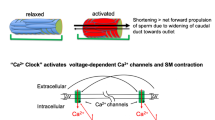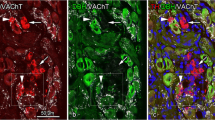Summary
Each of the 21 segmental ganglia in the American leechMacrobdella decora contains a pair of Leydig cells (ca. 45 μm) each of which is located in a posteriolateral glial packet. Leydig cells exhibit spontaneous action potentials (1–10/s) whose duration and undershoot depend upon membrane polarization. The two Leydig cells within each ganglion are bidirectionally-coupled (V 2/V 1≅0.3). Pairs of ipsilateral Leydig cells within adjacent ganglia are mutually excitatory such that an impulse in one generates an impulse in the other. The interganglionic latency for any cell pair is constant regardless of the direction of impulse conduction and is unchanged by 20 mM Mg2+ saline. These data indicate that the interactions are not mediated by chemical synapses. Additionally, the results of collision experiments lead us to infer that ipsilateral Leydig cell pairs utilize common axonal pathways for interganglionic interactions. If Leydig cells are driven by current injection to fire impulses at frequencies of six to ten per s, cells in adjacent ganglia exhibit impulse failures. The combination of spontaneous activity, intraganglionic coupling and interganglionic interactions results in the generation of constant, low frequency impulse activity and can cause impulse reverberations.
The branching pattern of Leydig cells filled with HRP is consistent with their functional properties and connectivity. Each cell sends axons to both adjacent ganglia through the ipsilateral connectives and projects to the periphery only by the lateral roots of these adjacent ganglia. This unusual morphology was verified Lucifer Yellow CH.
In addition to intraganglionic dye-coupling, dye coupling was occasionally evident between ipsilateral cells in adjacent ganglia. Electron microscopy of Leydig cells depicts abundant 100 nm granules in both their somata and neuropilar processes. Although this fine structure suggests a neurosecretory role, we were unable to discern a peripheral function for these neurons.
Similar content being viewed by others
Abbreviations
- H R P :
-
horseradish peroxidase
References
Bennett MVL (1973) Function of electrotonic junctions in embryonic and adult tissues. Fed Proc 32:65–75
Bristol CL (1898) The metamerism ofNephelis: A contribution of the morphology of the nervous system, with a description ofNephelis lateralis. J Morphol 15:17–72
Fomina MS, Tereshkov OD (1972) Electrical transmission between symmetrical neurons in leech ganglia. Neurosci Behav Physiol 5:91–96
Hermann E (1875) Das Centralnervensystem vonHirudo medicinalis. München
Kandel ER, Tauc L (1966) Anomolous rectification in the metacerebral giant cells and its consequences for synaptic transmission. J Physiol (Lond) 183:287–304
Kristan WBJr, Stent GS, Ort CA (1974) Neuronal control of swimming in the medicinal leech. III. Impulse patterns of the motoneurons. J Comp Physiol 94:155–176
Lent CM (1973) Retzius cells: Neuronal effectors controlling mucus release by the leech. Science 179:693–696
Leydig F (1864) Tafeln zur vergleichenden Anatomie. Laup, Tübingen
Macagno ER (1980) Number and distribution of neurons in leech segmental ganglia. J Comp Neurol 190:283–302
Mason A, Sunderland AJ, Leake LD (1979) Effects of leech Retzius cells on body wall muscles. Comp Biochem Physiol [C] 63:359–361
Muller KJ, Carbonetto S (1979) The morphological and physiological properties of a regenerating synapse in the C.N.S. of the leech. J Comp Neurol 185:485–516
Muller KJ, McMahan UJ (1976) The shapes of sensory and motor neurones and the distribution of their synapses in the ganglia of the leech: A study using intracellular injection of horseradish peroxidase. Proc R Soc Lond [Biol] 194:481–499
Nicholls JG, Baylor DA (1968) Specific modalities and receptive fields of sensory neurons in C.N.S. of the leech. J Neurophysiol 31:740–756
Nicholls JG, Purves D (1972) A comparison of chemical and electrical synaptic transmission between single sensory cells and a motoneurone in the central nervous system of the leech. J Physiol (Lond) 225:637–656
Spray DC, Harris AL, Bennett MVL (1979) Voltage dependence of junctional conductance in early amphibian embryos. Science 204:432–434
Stewart WW (1978) Functional connections between cells as revealed by dye-coupling with a highly fluorescent naphthalimide tracer. Cell 14:741–759
Stewart WW (1981) Lucifer dyes-highly fluorescent dyes for biological tracing. Nature 292:17–21
Stuart AE (1970) Physiological and morphological properties of motoneurons in the central nervous system of the leech. J Physiol (Lond) 209:627–646
Webb RA, Orchard I (1979) The distribution of putative neurosecretory cells in the central nervous system of the North American medicinal LeechMacrobdella decora. Can J Zool 57:1905–1914
Author information
Authors and Affiliations
Rights and permissions
About this article
Cite this article
Keyser, K.T., Frazer, B.M. & Lent, C.M. Physiological and anatomical properties of Leydig cells in the segmental nervous system of the leech. J. Comp. Physiol. 146, 379–392 (1982). https://doi.org/10.1007/BF00612707
Accepted:
Issue Date:
DOI: https://doi.org/10.1007/BF00612707




